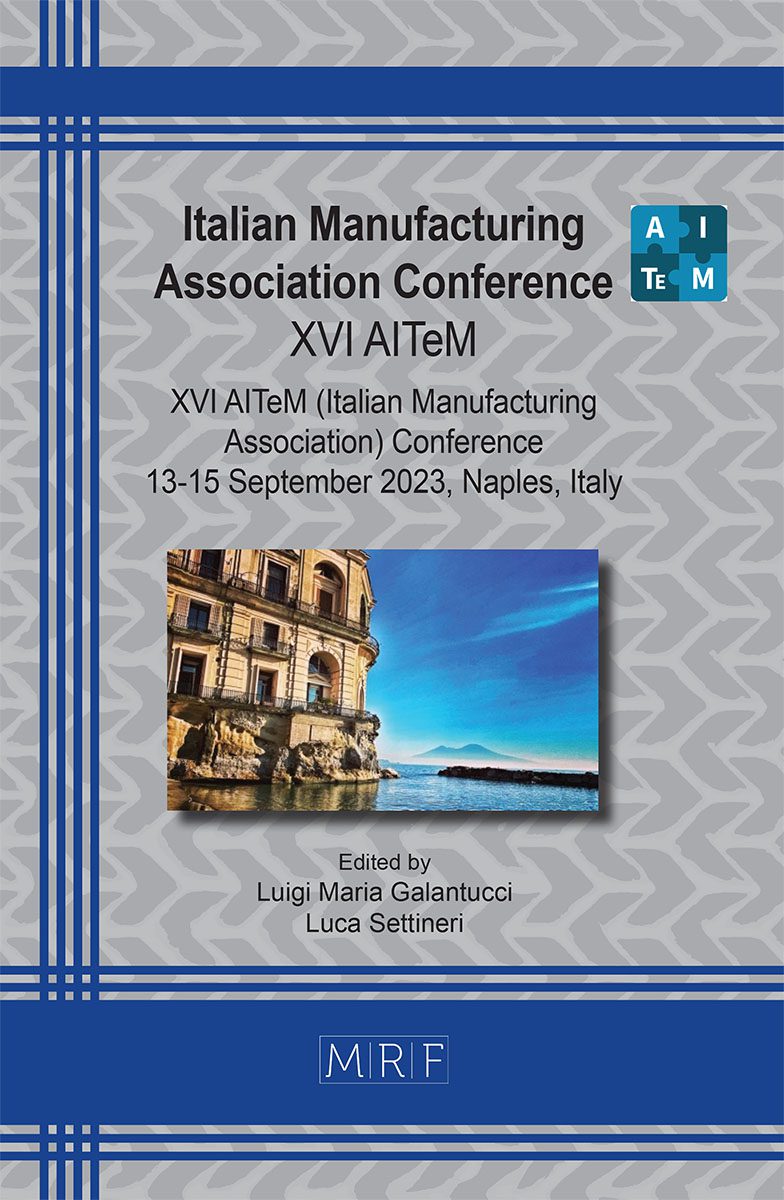Surface micro – texturing of tapping tools with complex geometry
Manuel Mazzonetto, Vincenzina Siciliani, Riccardo Pelaccia, Leonardo Orazi
download PDFAbstract. Lubrication control and tribological aspects affect all the machining operations: minimizing the friction coefficient, reducing the heat generated during machining or decreasing stresses during cutting operations are just some sought goals during machining. A fundamental aspect is also related to the drop of the amount of cutting fluid required during manufacturing processes. In fact, this can respond to issues related to the process sustainability thus allowing machining under MQL (Minimum Quantity Lubrication) conditions. The aim of this work is to propose an effective methodological procedure to texture cutting tools with complex geometry. A picosecond laser system operating at infrared frequency was used to structure the whole cutting tool surface. Rectangular dimples were selected as texture pattern to ensure the evaluation of the dimensions achieved by the dimples. Textured surfaces topography will allow the evaluation of the effectiveness of the developed process.
Keywords
Laser Machining, Texture, Cutting Tool
Published online 9/5/2023, 8 pages
Copyright © 2023 by the author(s)
Published under license by Materials Research Forum LLC., Millersville PA, USA
Citation: Manuel Mazzonetto, Vincenzina Siciliani, Riccardo Pelaccia, Leonardo Orazi, Surface micro – texturing of tapping tools with complex geometry, Materials Research Proceedings, Vol. 35, pp 359-366, 2023
DOI: https://doi.org/10.21741/9781644902714-43
The article was published as article 43 of the book Italian Manufacturing Association Conference
![]() Content from this work may be used under the terms of the Creative Commons Attribution 3.0 license. Any further distribution of this work must maintain attribution to the author(s) and the title of the work, journal citation and DOI.
Content from this work may be used under the terms of the Creative Commons Attribution 3.0 license. Any further distribution of this work must maintain attribution to the author(s) and the title of the work, journal citation and DOI.
References
[1] T. Obikawa, A. Kamio, H. Takaoka, and A. Osada, “Micro-texture at the coated tool face for high performance cutting,” Int J Mach Tools Manuf, vol. 51, no. 12, pp. 966–972, Dec. 2011. https://doi.org/10.1016/j.ijmachtools.2011.08.013
[2] H. Hanyu, S. Kamiya, Y. Murakami, and M. Saka, “Dry and semi-dry machining using finely crystallized diamond coating cutting tools,” Surf Coat Technol, vol. 173, pp. 992–995, 2003. https://doi.org/10.1016/S0257-8972Ž03.00688-1
[3] T. Obikawa, Y. Asano, and Y. Kamata, “Computer fluid dynamics analysis for efficient spraying of oil mist in finish-turning of Inconel 718,” Int J Mach Tools Manuf, vol. 49, no. 12–13, pp. 971–978, Oct. 2009. https://doi.org/10.1016/j.ijmachtools.2009.06.002
[4] T. Özel, D. Biermann, T. Enomoto, and P. Mativenga, “Structured and textured cutting tool surfaces for machining applications,” CIRP Annals, vol. 70, no. 2, pp. 495–518, Jan. 2021. https://doi.org/10.1016/j.cirp.2021.05.006
[5] N. Kawasegi, H. Sugimori, H. Morimoto, N. Morita, and I. Hori, “Development of cutting tools with microscale and nanoscale textures to improve frictional behavior,” Precis Eng, vol. 33, no. 3, pp. 248–254, Jul. 2009. https://doi.org/10.1016/j.precisioneng.2008.07.005
[6] T. Sugihara and T. Enomoto, “Development of a cutting tool with a nano/micro-textured surface-Improvement of anti-adhesive effect by considering the texture patterns,” Precis Eng, vol. 33, no. 4, pp. 425–429, Oct. 2009. https://doi.org/10.1016/j.precisioneng.2008.11.004
[7] T. Sugihara and T. Enomoto, “Improving anti-adhesion in aluminum alloy cutting by micro stripe texture,” Precis Eng, vol. 36, no. 2, pp. 229–237, Apr. 2012. https://doi.org/10.1016/j.precisioneng.2011.10.002
[8] Y. Xing, J. Deng, X. Wang, K. Ehmann, and J. Cao, “Experimental assessment of laser textured cutting tools in dry cutting of aluminum alloys,” Journal of Manufacturing Science and Engineering, Transactions of the ASME, vol. 138, no. 7, Jul. 2016. https://doi.org/10.1115/1.4032263
[9] S. Lei, S. Devarajan, and Z. Chang, “A study of micropool lubricated cutting tool in machining of mild steel,” J Mater Process Technol, vol. 209, no. 3, pp. 1612–1620, Feb. 2009. https://doi.org/10.1016/j.jmatprotec.2008.04.024
[10] J. Kümmel et al., “Study on micro texturing of uncoated cemented carbide cutting tools for wear improvement and built-up edge stabilisation,” J Mater Process Technol, vol. 215, pp. 62–70, 2015. https://doi.org/10.1016/j.jmatprotec.2014.07.032
[11] Y. Lian, J. Deng, G. Yan, H. Cheng, and J. Zhao, “Preparation of tungsten disulfide (WS2) soft-coated nano-textured self-lubricating tool and its cutting performance,” International Journal of Advanced Manufacturing Technology, vol. 68, no. 9–12, pp. 2033–2042, Oct. 2013. https://doi.org/10.1007/s00170-013-4827-y
[12] W. Ze, D. Jianxin, C. Yang, X. Youqiang, and Z. Jun, “Performance of the self-lubricating textured tools in dry cutting of Ti-6Al-4V,” International Journal of Advanced Manufacturing Technology, vol. 62, no. 9–12, pp. 943–951, Oct. 2012. https://doi.org/10.1007/s00170-011-3853-x
[13] I. Etsion, G. Halperin, V. Brizmer, and Y. Kligerman, “Experimental investigation of laser surface textured parallel thrust bearings.”
[14] S. Bai, X. Peng, Y. Li, and S. Sheng, “A hydrodynamic laser surface-textured gas mechanical face seal,” Tribol Lett, vol. 38, no. 2, pp. 187–194, May 2010. https://doi.org/10.1007/s11249-010-9589-1
[15] W. Grabon, W. Koszela, P. Pawlus, and S. Ochwat, “Improving tribological behaviour of piston ring-cylinder liner frictional pair by liner surface texturing,” Tribol Int, vol. 61, pp. 102–108, 2013. https://doi.org/10.1016/j.triboint.2012.11.027
[16] R. Sasi, S. Kanmani Subbu, and I. A. Palani, “Performance of laser surface textured high speed steel cutting tool in machining of Al7075-T6 aerospace alloy,” Surf Coat Technol, vol. 313, pp. 337–346, Mar. 2017. https://doi.org/10.1016/j.surfcoat.2017.01.118
[17] S. Durairaj, J. Guo, A. Aramcharoen, and S. Castagne, “An experimental study into the effect of micro-textures on the performance of cutting tool,” International Journal of Advanced Manufacturing Technology, vol. 98, no. 1–4, pp. 1011–1030, Sep. 2018. https://doi.org/10.1007/s00170-018-2309-y































